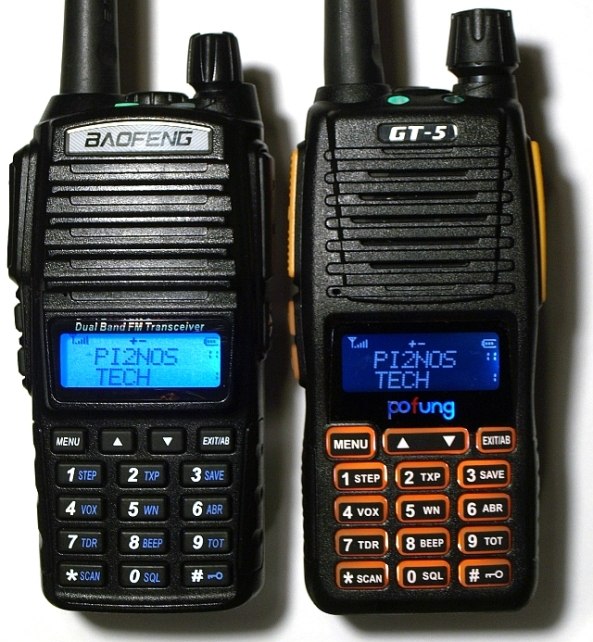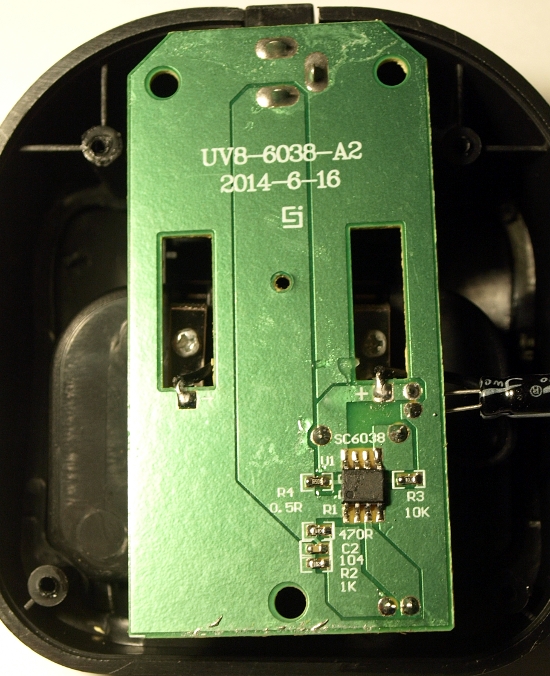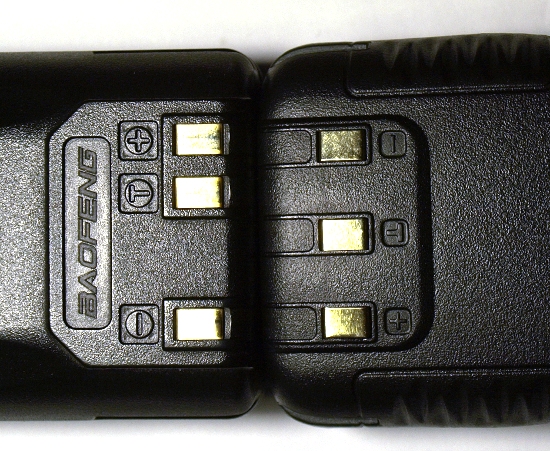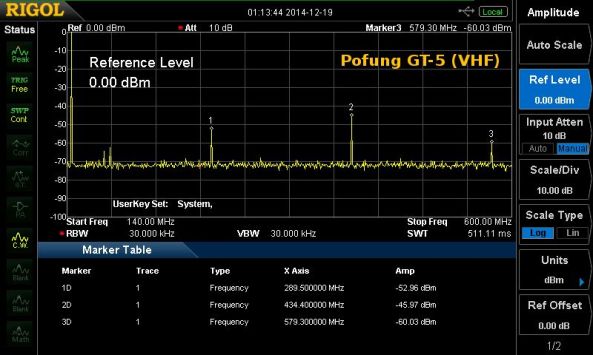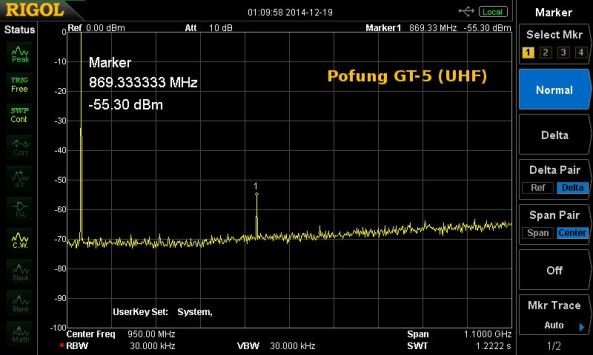Monthly Archives: December 2014
Review Baofeng GT-3TP
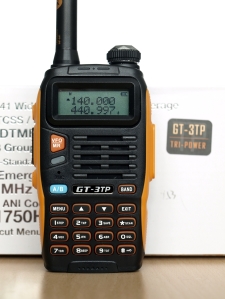 This is a short review – the Baofeng GT-3TP from Sainsonic is essentially a GT-3 Mark II with some extra power on board. If you didn’t read that review, you might want to do so before continuing.
This is a short review – the Baofeng GT-3TP from Sainsonic is essentially a GT-3 Mark II with some extra power on board. If you didn’t read that review, you might want to do so before continuing.
The radio has the same advantages (good TX audio, good front-end, no rounding down errors when entering frequencies by hand), but there are some differences too.
Display
The LCD of this radio is not of a fancy ‘reverse’ type, but the good ol’ three-color version.
Frequency range
My review sample had an unusual frequency range: 140 – 160 MHz and 430 – 441 MHz. Because my sample came directly from Sainsonic’s head office, I think that this particular radio was originally intended for another region. It’s not really important; if you want a wider range you can set other boundaries by software.
Power output
This is what everyone likes about these radios: more power. A standard UV-5R or GT-3 will deliver around 4 Watts on VHF and 3 Watts on UHF. Note: those few extra Watts won’t help you much if you want to extend your range. Range depends for 99% on other factors, such as terrain and antenna height. The battery will drain much faster though.
Measurements @ 145 MHz and 435 MHz respectively:
VHF: 6.3 Watts (Hi), 4.9 Watts (Mid), 1.9 Watts (Low)
UHF: 5.0 Watts (Hi), 4.5 Watts (Mid), 1.4 Watts (Low)
As you can see the difference between Hi and Mid on the UHF band is very small.
Harmonic suppression
Not really impressive; especially on UHF.
Programming with Chirp
The Baofeng GT-3TP can be programmed with Chirp by using the existing support for the BF-F8HP.
 Conclusion
Conclusion
The GT-3TP is one of the many ‘triple powers’ on the market. The last one I reviewed was the Intek KT-980HP, and some results are comparable. The Intek did much better on harmonic suppression, but the GT-3TP wins with its receiver and much better antenna.
Bottom line: you will get a nice radio with upgraded chipset, a few Watts more output power, a good antenna and good looks. Buy a spare battery if you intend to use the highest power settings all the time!
Merry Christmas!
Merry Christmas! Don’t eat too much, and don’t be too greedy…
Baofeng -> Pofung -> Misutā
It seems that another name change is coming up: Misutā. The word ‘Misutā’ (ミスター) is Japanese for ‘Mister’, a bit of a strange name for a 2-way radio. A Japanese name for a Chinese radio is strange no matter how you look at it. Sorry gents, the legendary Japanese quality won’t rub off, whatever label you stick on it.
Two models are on display so far: the Misutā Samurai, and the Misutā Hero. Both are, of course, UV-5Rs, with reverse LCDs. Prices are about the same.
It must be said: Misutā sounds better than Pofung (which is often pronounced as poo fung, and people try really hard not to grin or laugh while doing that).
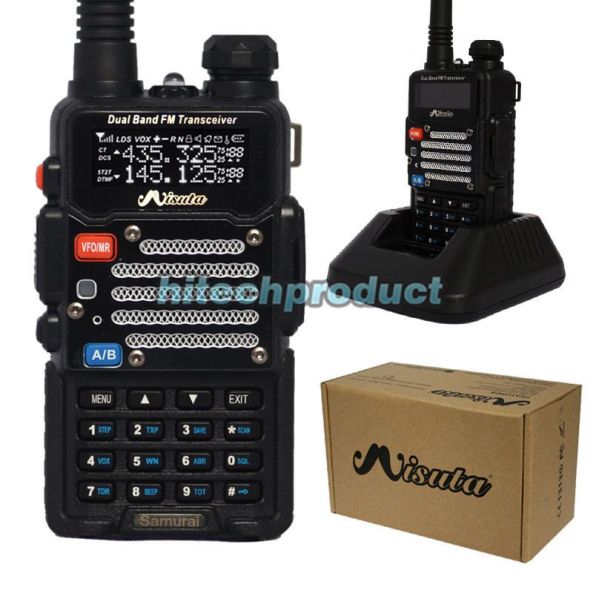 eBay seller hitechproduct has these radios on sale.
eBay seller hitechproduct has these radios on sale.
Review Pofung (Baofeng) GT-5
This is more a heads-up than a review, because the Baofeng GT-5 is essentially a Baofeng UV-82 in a more modern looking package. In turn the UV-82 was just a bigger UV-5R. Same electronics, same behavior, but fortunately shipped with a much better antenna.
Rumors that the GT-5 would have new features on board, such as a compander, are false.
It didn’t come as a surprise that the Pofung GT-5 can be programmed with Chirp out of the box — just select the Baofeng UV-82 from the list of radios.
I still like the old UV-82. Actually I like the UV-82 more now than when the radio was first introduced. The Dual PTT key started to grow on me, for example. At first I argued that it was a rather confusing feature.
I was wrong, you actually start to rely on it. The Dual PTT key is very useful when you have the radio in Dual Standby mode. When you monitor two repeaters, you can hear which VFO becomes active by listening to the CW identifier and start to transmit instantly by pressing the correct PTT button. On other radios you have to check if the correct VFO is active or not.
The extra 1 Watt of power on both bands (5/4 Watts instead of 4/3 Watts) was a bonus, and the larger cabinet improved RX audio a bit (probably a matter of acoustics). The radio’s size is nice, feels solid, and the looks were less toyish.
The first batch of UV-82 chargers really sucked. According to new UV-82 owners Baofeng eventually fixed that. No such mistakes here. While simply constructed, the charger uses wiring to connect the battery to the charger circuitry. Caution: wiring is not color coded, all they use is black.
The UV-82 was also subject to lies regarding battery capacity. Many batteries were sold as 2800 mAh or even higher, but it quickly became clear that these batteries were ‘mislabeled’. Yup, they were all 1800 mAh, just like the original.
Power Output hardly changed:
VHF (145 MHz)
Low: 2.3 Watts
High: 5.2 Watts
UHF (435 MHz)
Low: 1.3 Watts
High: 4.1 Watts
Harmonic suppression
A bit messy on VHF (see marker 2D, third harmonics), not too bad on UHF.
- Reverse LCD (aka Stealth Display) instead of the original three-color one. The backlight color settings are still present in the menu, but don’t do much. By setting menu 29, 30 and 31 to ‘Purple’ you will get the best brightness.
- Slightly better ergonomics. Some rough feeling edges were traded for smoother ones.
- The functions printed on the keys have an excellent readability, with or without backlight.
- I noticed that the injection molding process, used to put information on the keys, improved significantly. The information on the keys doesn’t seem to fade, nor does it wear down as quickly as on other radios. The keys on my first GT-3, which are identical, are still in pristine condition. The information on the keys of my UV-5R and UV-B5 on the other hand disappeared almost completely.
- Dual PTT key is flat now. It looks better, but provides less tactile feedback.
- Antenna performs as well as the one supplied with the UV-82. Early pictures suggested that the short, dreaded UV-5R stock antenna would be in the box. Fortunately that’s not the case.
GT-5, disadvantages
- Battery and charger incompatible with the UV-82.
- Lack of accessories at introduction.
- Reverse LCD very hard to read in low light
- ‘Rounding down’ bug survived in this model; the last digits of a frequency typed in by hand won’t be predicted correctly when the radio is set to 12.5 or 6.25 MHz steps.
- Holding Menu while switching on the radio in order to switch back and forth from channel mode to VFO mode isn’t the most user-friendly way to do things, but it might help getting the radio Part 90 approved, like the UV-82C.
- No detectable differences / improvements in the receiver section when compared to the UV-82.
Conclusion
The Pofung GT-5 is a very pretty looking radio; almost everyone I talked to said something along the lines of “Wow”. I have to agree with them. Both TX and RX audio are excellent, the radio performs as well as you’d expect, but unlike the GT-3 Mark II the GT-5 is just an example of old wine in a new bottle.
Would I choose the GT-5 over the UV-82? Yes, mainly for its looks, and assuming there isn’t too much of a price gap between the two models. It’s matter of taste — yet again. I only wished that Pofung had done a better job suppressing harmonics on VHF.
I have no information on pricing yet; so keep an eye on the obvious sources. A removed listing on amazon.co.uk (but still in Google’s cache) mentioned a price of 35 UK pounds. That wouldn’t be bad at all.



